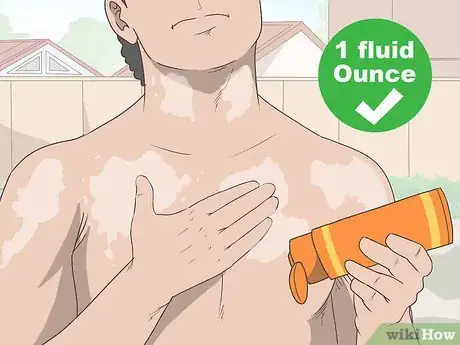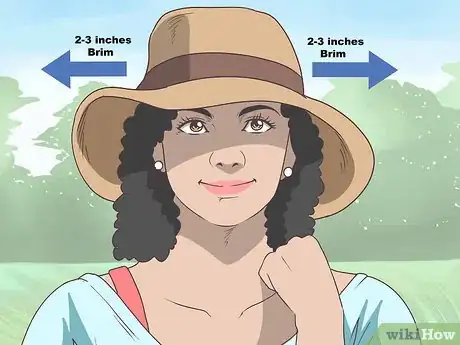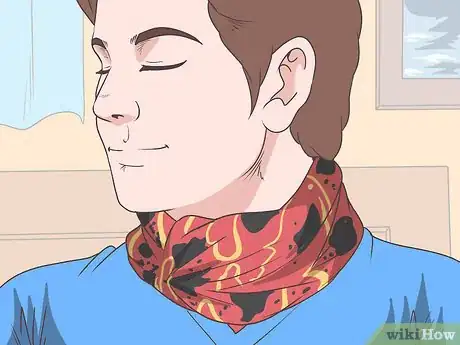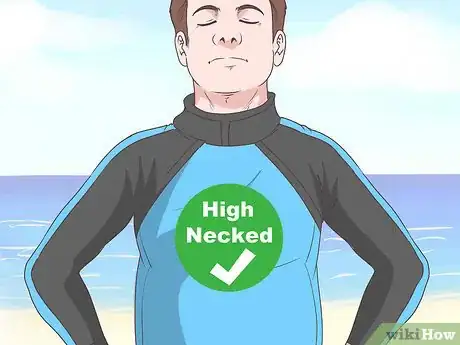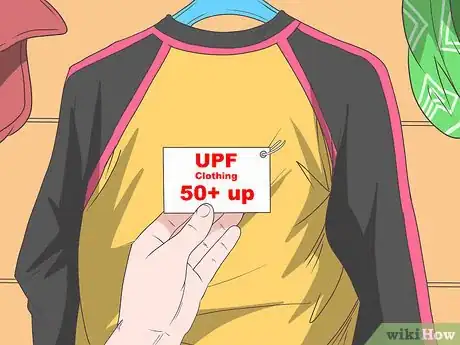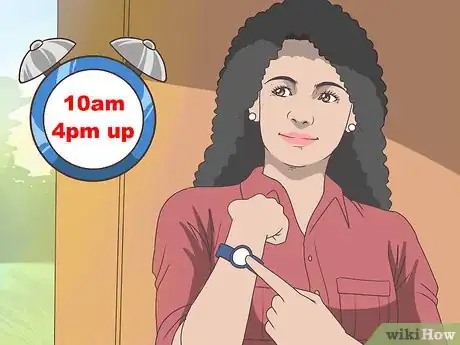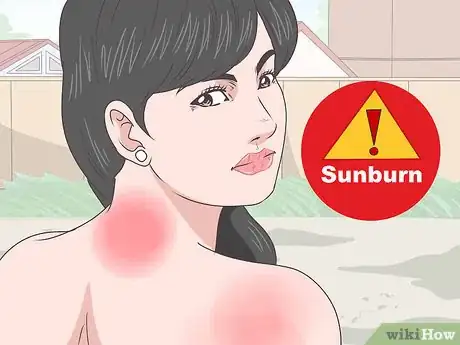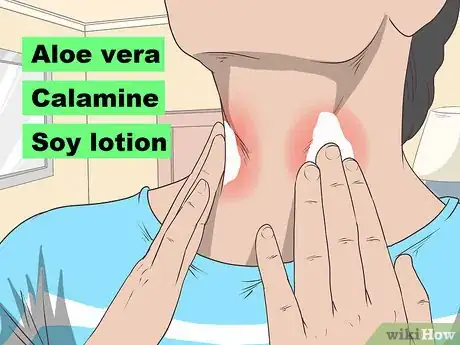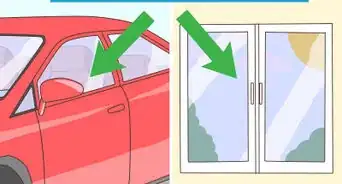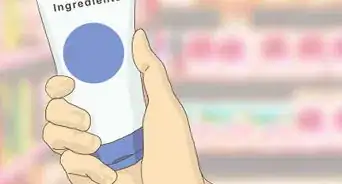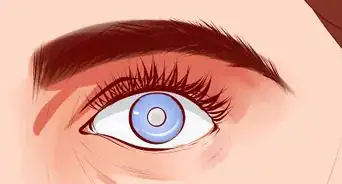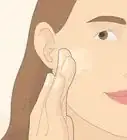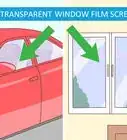This article was co-authored by Mohiba Tareen, MD. Mohiba Tareen is a board certified Dermatologist and the founder of Tareen Dermatology located in Roseville, Maplewood and Faribault, Minnesota. Dr. Tareen completed medical school at the University of Michigan in Ann Arbor, where she was inducted into the prestigious Alpha Omega Alpha honor society. While a dermatology resident at Columbia University in New York City, she won the Conrad Stritzler award of the New York Dermatologic Society and was published in The New England Journal of Medicine. Dr. Tareen then completed a procedural fellowship which focused on dermatologic surgery, laser, and cosmetic dermatology.
There are 7 references cited in this article, which can be found at the bottom of the page.
This article has been viewed 41,964 times.
It’s easy to remember to protect your face from the sun’s rays, but your neck also needs to be shielded. There are plenty of steps you can take to keep the skin on your neck safe, though. Keeping your skin healthy requires effort, but it’s worth it in the long run.
Steps
Using Sunscreen for Protection
-
1Apply a high SPF, broad spectrum sunscreen.[1] No sunscreen can guarantee you complete protection, but an SPF 100 sunscreen blocks about 99% of the sun’s harmful UVB rays. Make sure it is labeled as broad spectrum, so that it will protect you from UVA rays as well.[2]
- Look for a waterproof or sweat-proof sunscreen as well. Check to see if it will protect your neck for 40 or 80 minutes under wet conditions.
- For even more protection, rub on a layer of lotion sunscreen. Then, follow it with an application of sprayed sunscreen.
-
2Rub on 1 fluid ounce (30 ml) of sunscreen across your upper body, including your neck. Most people make the mistake of applying too little sunscreen for proper protection. Be generous when working the sunscreen into your skin. Use your fingers to feel across your neck to ensure that it is entirely covered.[3]
- It’s generally best to apply your sunscreen at least 15 minutes before going out into the sun. This gives the sunscreen time to form a protective barrier over your skin.[4]
Advertisement -
3Re-apply sunscreen to your neck every 2 hours. Sunscreen will eventually wear off and lose its effectiveness under normal conditions.[5] If you are swimming or if you wipe your neck with a towel, then you may need to re-apply even sooner. Just to be clear, a higher SPF does not mean that it lasts longer.[6]
Protecting Your Neck with Clothing
-
1Wear a hat with a 2 to 3 inches (5.1 to 7.6 cm) brim.[7] A standard baseball cap can leave your neck and ears vulnerable to the sun. Putting on a hat with an extended brim guarantees that your neck will be slightly blocked from the sun. A straw hat can provide some protection, but a close knit fabric hat is even better.[8]
- Some hats come with a reflective underside that actually repels the sun’s rays.
- It’s estimated that your skin cancer risk lowers by 10% for every 2 inches added to your hat’s brim.
-
2Don a shade cap. This is a hat that fits close to your head, like a baseball cap. However, it also has long, dense fabric draping from the sides and back. This fabric covers your ears and neck, shielding them from the sun. Buy a shade cap from your local sporting goods or outdoor store.[9]
-
3Wrap a bandana around your neck. Bandanas are lightweight, square pieces of fabric that can be easily folded into a neck wrap. You can tie the ends to the front or side of your neck. Adjust the fall of the fabric until if covers your neck from all sides.[10]
- If it’s extremely hot, soak your bandana in cold water before placing it on your neck for extra relief.
- If you don’t have a bandana, any piece of square fabric can really work the same way.
-
4Wear a high-necked shirt. If you are hitting the beach or swimming, look for a rash guard shirt with a neck that extends a few inches above your shoulders. This will block the sun without overheating you in the process. Many outdoor companies also sell lightweight shirts with extended, sometimes detachable, neck pieces.[11]
- Check that the top is relatively tight-fitting or it could flop down and expose part of your neck to the sun.
-
5Select UPF clothing. Look for high-neck shirts, bandanas, or hats that are UPF rated. The UPF rating goes from 15 to 50+, with the higher numbers offering more protection from UVA and UVB rays. The UPF rating only holds true if the garment stays dry, though.
- For example, if you are going to be in the sun for extended periods of time, go with a 40+ UPF rating, as it can block around 98% of UV rays. A rating between 25-35 is a good option for brief periods of sun exposure.
- Look for a sun wrap, which is a piece of fabric that sticks out from under your hat or drapes over your shoulders. This is a good option to protect your neck.
Minimizing the Sun’s Effects
-
1Limit your sun exposure between 10am and 4pm. These are the peak periods of UV rays and the time when you are most likely to get burned. If the sun is high in the sky and your shadow is very short, then that heat is likely intense. Try to stay indoors during these hours or spend some time in the shade.
-
2Carry or sit underneath an umbrella. Create your own shade by using an umbrella at the beach or by carrying an umbrella if you are walking around. Look for an umbrella with a high UPF protection rating. To fully cover your neck, lean the arm of the umbrella against your shoulder, so that’s its angled back.[12]
- Some umbrellas even have vented seams to allow for more air flow.
-
3Pay attention to the feel of your skin. If you are out in the sun and the back of your neck starts to feel painful, then it’s time to seek the shade. Your skin might also feel overly hot to the touch. Another sign of a possible sunburn is skin that feels tight, sticky, or stretched out.
- To test for sunburn, press down on your skin with your finger. If your skin goes from white to red, you may be developing a sunburn.
-
4Treat a burned neck with aloe vera, soy, or calamine lotion.[13] If your neck is red or painful, rub a bit of lotion into the skin. You can also take an OTC medication, such as ibuprofen, to help with the pain and swelling. Stay out of the sun until your neck, and other burned areas, are fully healed.[14]
- Do not use lotions containing petroleum, benzocaine, or lidocaine on a sunburn.
- Make sure to follow dosage or application instructions for any OTC medications or lotions.
- For some relief, place a cool, damp cloth around your sun-burned neck once or twice a day until it heals.
- Cover sunburned skin while it heals so that the burn doesn't worsen.
- If blisters develop, do not pop or pick them. Leave them alone while they heal.
- If you feel dizzy, weak, cold, feverish, or sick to your stomach, see a doctor.
Expert Q&A
Did you know you can get expert answers for this article?
Unlock expert answers by supporting wikiHow
-
QuestionHow can I protect my face from the sun without sunscreen?
 Mohiba Tareen, MDMohiba Tareen is a board certified Dermatologist and the founder of Tareen Dermatology located in Roseville, Maplewood and Faribault, Minnesota. Dr. Tareen completed medical school at the University of Michigan in Ann Arbor, where she was inducted into the prestigious Alpha Omega Alpha honor society. While a dermatology resident at Columbia University in New York City, she won the Conrad Stritzler award of the New York Dermatologic Society and was published in The New England Journal of Medicine. Dr. Tareen then completed a procedural fellowship which focused on dermatologic surgery, laser, and cosmetic dermatology.
Mohiba Tareen, MDMohiba Tareen is a board certified Dermatologist and the founder of Tareen Dermatology located in Roseville, Maplewood and Faribault, Minnesota. Dr. Tareen completed medical school at the University of Michigan in Ann Arbor, where she was inducted into the prestigious Alpha Omega Alpha honor society. While a dermatology resident at Columbia University in New York City, she won the Conrad Stritzler award of the New York Dermatologic Society and was published in The New England Journal of Medicine. Dr. Tareen then completed a procedural fellowship which focused on dermatologic surgery, laser, and cosmetic dermatology.
FAAD Board Certified Dermatologist
-
QuestionHow can you stay safe in the sun?
 Mohiba Tareen, MDMohiba Tareen is a board certified Dermatologist and the founder of Tareen Dermatology located in Roseville, Maplewood and Faribault, Minnesota. Dr. Tareen completed medical school at the University of Michigan in Ann Arbor, where she was inducted into the prestigious Alpha Omega Alpha honor society. While a dermatology resident at Columbia University in New York City, she won the Conrad Stritzler award of the New York Dermatologic Society and was published in The New England Journal of Medicine. Dr. Tareen then completed a procedural fellowship which focused on dermatologic surgery, laser, and cosmetic dermatology.
Mohiba Tareen, MDMohiba Tareen is a board certified Dermatologist and the founder of Tareen Dermatology located in Roseville, Maplewood and Faribault, Minnesota. Dr. Tareen completed medical school at the University of Michigan in Ann Arbor, where she was inducted into the prestigious Alpha Omega Alpha honor society. While a dermatology resident at Columbia University in New York City, she won the Conrad Stritzler award of the New York Dermatologic Society and was published in The New England Journal of Medicine. Dr. Tareen then completed a procedural fellowship which focused on dermatologic surgery, laser, and cosmetic dermatology.
FAAD Board Certified Dermatologist
-
QuestionWhat can I put on my sunburn other than aloe?
 Mohiba Tareen, MDMohiba Tareen is a board certified Dermatologist and the founder of Tareen Dermatology located in Roseville, Maplewood and Faribault, Minnesota. Dr. Tareen completed medical school at the University of Michigan in Ann Arbor, where she was inducted into the prestigious Alpha Omega Alpha honor society. While a dermatology resident at Columbia University in New York City, she won the Conrad Stritzler award of the New York Dermatologic Society and was published in The New England Journal of Medicine. Dr. Tareen then completed a procedural fellowship which focused on dermatologic surgery, laser, and cosmetic dermatology.
Mohiba Tareen, MDMohiba Tareen is a board certified Dermatologist and the founder of Tareen Dermatology located in Roseville, Maplewood and Faribault, Minnesota. Dr. Tareen completed medical school at the University of Michigan in Ann Arbor, where she was inducted into the prestigious Alpha Omega Alpha honor society. While a dermatology resident at Columbia University in New York City, she won the Conrad Stritzler award of the New York Dermatologic Society and was published in The New England Journal of Medicine. Dr. Tareen then completed a procedural fellowship which focused on dermatologic surgery, laser, and cosmetic dermatology.
FAAD Board Certified Dermatologist
Warnings
References
- ↑ Mohiba Tareen, MD. FAAD Board Certified Dermatologist. Expert Interview. 26 March 2020.
- ↑ https://www.cancer.org/cancer/skin-cancer/prevention-and-early-detection/uv-protection.html
- ↑ https://www.cancer.org/cancer/skin-cancer/prevention-and-early-detection/uv-protection.html
- ↑ Mohiba Tareen, MD. FAAD Board Certified Dermatologist. Expert Interview. 26 March 2020.
- ↑ Mohiba Tareen, MD. FAAD Board Certified Dermatologist. Expert Interview. 26 March 2020.
- ↑ https://www.cancer.org/cancer/skin-cancer/prevention-and-early-detection/uv-protection.html
- ↑ Mohiba Tareen, MD. FAAD Board Certified Dermatologist. Expert Interview. 26 March 2020.
- ↑ https://www.cancer.org/cancer/skin-cancer/prevention-and-early-detection/uv-protection.html
- ↑ https://www.cancer.org/cancer/skin-cancer/prevention-and-early-detection/uv-protection.html
- ↑ https://www.outdoors.org/articles/amc-outdoors/emergency-sun-protection-for-your-face
- ↑ https://www.skincancer.org/prevention/sun-protection/clothing/protection
- ↑ https://www.today.com/style/here-s-why-you-should-be-protecting-your-scalp-summer-t98056
- ↑ Mohiba Tareen, MD. FAAD Board Certified Dermatologist. Expert Interview. 26 March 2020.
- ↑ https://www.nhs.uk/livewell/skin/pages/sunsafe.aspx
- ↑ https://www.cancer.org/cancer/skin-cancer/prevention-and-early-detection/uv-protection.html
- ↑ http://www.espn.com/espnw/athletes-life/article/13300949/pro-tips-protecting-your-skin-working-sun


